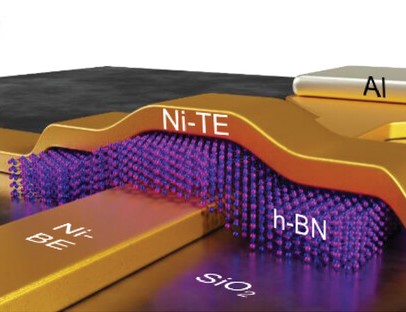Conduction and switching mechanisms in boron-nitride threshold memristors with nickel electrodes
Researchers from RWTH Aachen University, AMO GmbH and Research Center Jülich have performed a detailed study of hBN based threshold memristors with nickel electrodes. Analyzing temperature-dependent transport measurements and high-resolution TEM images, they propose the formation and retraction of nickel filaments along boron defect in the h-BN film as the resistive switching mechanism. The study has been reported in Advanced Functional Materials.

Schematics of a niobium hBN-based memristo r with nickel electrodes.
Memristors – the name is a contraction of “memory resistor” – are promising building blocks for next-generation non-volatile memory and bio-inspired computing systems. The special property of these passive circuit elements is that their resistance can be “programmed” (either volatile or non-volatile) by applying an external voltage. Memristive phenomena have been observed in various materials such as metal oxides, chalcogenides, amorphous silicon, and two-dimensional (2D) materials, but the search for a material platform that could bring memristor-technology from lab to fab is still open.
Recently, hexagonal boron nitride (hBN) has become a popular material for investigating resistive switching, as it offers several favorable properties like high in-plane thermal conductivity, thermal and chemical stability, mechanical flexibility and a wide bandgap (about 6 eV) that enables a large switching window. Moreover, its layered van der Waals structure enables integration on arbitrary substrates and pristine interfaces.
Researchers from RWTH Aachen University, AMO GmbH and Research Center Jülich have performed a detailed study of hBN-based threshold memristors with nickel electrodes, showing that these devices – which are based on CMOS-compatible materials – compare well with state-of-the-art devices. The devices show a tunable current operation window, low cycle-to-cycle variability and a large On/Off ratio.
One of the most interesting aspects of the work is the accurate investigation of the current conduction mechanism in their devices. By performing temperature-dependent current-voltage measurements both in the high- and in the low-resistance states and by comparing the measured data with different theoretical model, the researchers have been able to point at the crucial role played by defects in the h-BN for understanding the behavior of the devices. Their measurements indicate that conduction in the high-resistance state occurs via defect-supported hopping through the h-BN, while resistive-switching can be understood in terms of formation and retraction of nickel filaments along boron defects in the h-BN – a conclusion supported by high-resolution transmission electron microscopy (TEM) analysis.
The results have been published in Advanced Functional Materials. Financial support for the research was provided by German Federal Ministry of Education and Research, BMBF, within the projects NEUROTEC, NEUROTEC 2, and NeuroSys.
Bibliographic Information:
“Resistive Switching and Current Conduction Mechanisms in Hexagonal Boron Nitride Threshold Memristors with Nickel Electrodes”, Lukas Völkel, Dennis Braun, Melkamu Belete, Satender Kataria, Thorsten Wahlbrink, Ke Ran, Kevin Kistermann, Joachim Mayer, Stephan Menzel, Alwin Daus, Max C. Lemme, Advanced Functional Materials, Adv. Funct. Mater. 2023, 2300428. https://doi.org/10.1002/adfm.202300428





